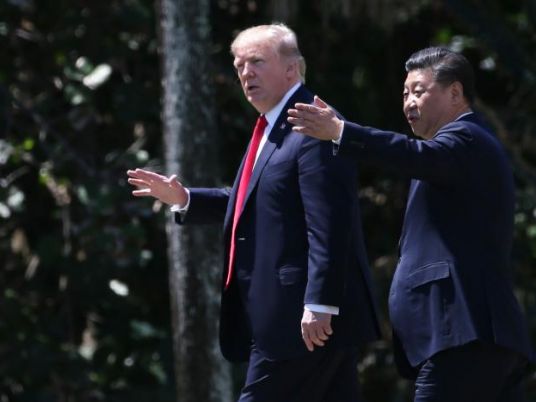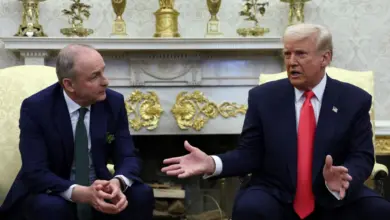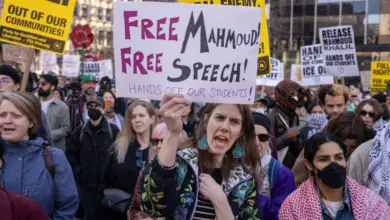
US Treasury Secretary Steven Mnuchin will lead a delegation to Beijing this week to meet with Chinese officials and try to ease the escalating trade dispute between the world’s two largest economies.
The meetings set for Thursday and Friday are the highest-level in-person talks since US President Donald Trump announced tariffs on $50 billion in Chinese goods in early April, a move quickly matched by China.
Although Trump has railed against the US trade deficit with China, and threatened to impose tariffs on a further $100 billion in Chinese goods, the dispute reflects Washington’s growing impatience over China’s industrial policies and market access restrictions.
China, for its part, increasingly sees itself as operating from a position of economic strength under President Xi Jinping. Beijing has expressed willingness to negotiate and ease restrictions on participation in sectors including autos and finance, but it is less likely to yield on its longer-term practice of providing heavy state support to key industries.
Since Trump’s threat of further tariffs, Chinese officials have walked back, at least publicly, suggestions that they would cut a deal. They have stated repeatedly that moves to open the country’s economy will be made at a pace that suits Beijing, not as concessions to US demands.
Nonetheless, bipartisan support for countering China’s trade practices has grown in Washington, where policymakers increasingly voice a need to inflict some cost upon Beijing for what they see as predatory state capitalism.
Even if the two sides strike a truce or agree to a cooling-off, deep differences over Chinese industrial policy are expected by many economists, industry officials and diplomats to persist for the foreseeable future.
TRADE GAP
The Trump administration has demanded that China immediately cut $100 billion from what it says is a $375 billion trade surplus with the United States. China argues that the United States should increase its own exports, pointing out strong Chinese demand for US high-tech products on which Washington imposes export restrictions.
The US business community has warned that Trump should not be fixated upon the trade deficit, and should instead focus on opening market access for US companies in China. Many economists argue tariffs – sure to elicit a Chinese backlash – would hit US consumers and may not change prevailing trade dynamics.
IP THEFT AND FORCED TECHNOLOGY TRANSFER
US complaints about Chinese intellectual property, or IP, abuses are at the core of the current dispute. The Trump administration says US companies lose hundreds of billions of dollars annually to China’s theft of trade secrets.
Washington points to weak IP protection in Chinese courts run by the ruling Communist Party, which has set explicit requirements for replacing foreign technology with home-grown alternatives.
The US Trade Representative’s Office also accuses Beijing of often making access to key Chinese markets conditional upon tacit agreements that American companies transfer technology and other IP to Chinese partners, which Beijing denies.
Chinese authorities have taken measures to step up IP enforcement, although critics argue progress is largely in terms of copyright and trademark enforcement, while technology transfer in strategic industries remains rampant.
MADE IN CHINA 2025
China is looking to catch up with rivals like the United States and Germany in high-end technology by pouring billions of dollars into its “Made in China 2025” strategy to turbocharge development in 10 key sectors, including robotics, aerospace and clean-energy cars.
The drive is core to Xi’s push to make China an advanced economy and less reliant on imports of key technologies from its industrial rivals. It is less likely to be an area where Beijing would cede ground to placate U.S. negotiators.
Trump’s chief trade negotiator, Robert Lighthizer, due to join this week’s talks, said on Tuesday he was not looking to negotiate changes to China’s state-driven economic system, but would seek to expose it to more foreign competition.
INVESTMENT RESTRICTIONS
Both countries restrict investment in key sectors, with the United States’ tightening access through its CFIUS legislation and planning to further curb Chinese access in certain industries.
China’s trade partners, including some officials in the European Union, have warned that increased scrutiny of Chinese foreign investment would be an inevitable response to a lack of reciprocal access for their companies in China.
Xi has promised to raise the foreign ownership limits in the automobile, shipbuilding and aircraft sectors “as soon as possible” and push previously announced measures to open the financial sector.
Washington has looked skeptically upon such pledges, given what it considers vague, unfulfilled promises in the past.
The foreign business community in China sees such reforms as long overdue and potentially too late: domestic competitors have used decades of being sheltered from foreign competition to establish dominant market positions at home while expanding abroad.
CURRENCY
Trump last month accused Russia and China of devaluing their currencies while the United States raises interest rates, which Mnuchin later described as a “warning shot.” Indeed, the dollar has weakened substantially against the Chinese yuan since Trump took office.
Another point of leverage China holds is its $1 trillion-plus portfolio of U.S. Treasury bonds. But deploying the so-called “nuclear option” of slashing its Treasury holdings would be self-defeating for China, undermining the value of its portfolio, driving up its own currency and making its exports more expensive.




